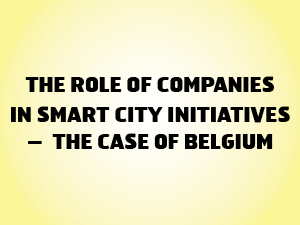
Anne-Marie André
Anne-Marie André, Researcher, Smart City Institute, HEC Liege, University of Liege (Belgium) ...
Voir l'auteur ...Nathalie Crutzen
Nathalie Crutzen, Associate Professor, Director, Smart City Institute, HEC Liege, University of Liege (Belgium)...
Voir l'auteur ...The role of companies in smart city initiatives - the case of belgium
Introduction
More than half of the world’s population lives in urban areas and this percentage rises to more than 66 % in the European Union (Eurostat, 2014). The fast growth of the urban population implies numerous economic and societal challenges in domains such as mobility, housing, employment, education, culture, security and natural resource management such as water, waste and energy (Nam and Padro, 2011).
More specifically, in Belgium, the population will grow from 11,2 million inhabitants in 2015 to 12,1 million in 2030 and 12,7 million inhabitants in 2060.In our country, 98 % of the population lives in urban areas(Federal Planning Bureau, 2015).This evolution requires real reflections and actions for a sustainable development of these urban ecosystems and a better quality of life for the citizens.
In this context, the concept of “smart city” emerges more and more to limit the problems inferred by the growth of the urban population and to find innovative solutions to meet this challenge. Actually, there is a tremendous and increasing interest in smart cities at the international, European, national and regional levels. All over the world, the multiplication of platforms and other initiatives demonstrate this increasing interest.
Nevertheless, up to now, there is no generally accepted definition of this concept in the literature and in practice. A few years ago, technology-centred approaches were predominant (Washburn et Sindhu, 2009). Nevertheless, overtime, broader definitions and more global approaches including the three pillars of sustainability and human and social capital for example, have emerged (Chourabi et al, 2012; Kourtit and Nijkamp, 2012).
This research project has been conducted in the spirit of the Sustainable Living in Cities European Business Campaign (CSR Europe)1 which aims to work with business, national partner organisations, policy makers, urban sustainability experts and city stakeholders, towards the creation of local and regional sustainability alliances for the acceleration of urban sustainable development. The territorial alliances will lay the necessary ground for companies to identify, seize and scale up opportunities in a smart, sustainable and inclusive way.
In this context, for the purpose of this research, we have chosen to define a smart city as follows.
A “smart city” is a multi-stakeholders’ ecosystem (composed with local governments, citizens’ associations, multinational and local businesses, universities, international institutions…) engaged in a sustainability strategy using technologies (ICT, engineering, hybrid technologies) as enabler.
Smart Cities have been further defined along six axes (Giffinger, 2007):
- Smart Economy
- Smart Mobility
- Smart Environment
- Smart People
- Smart Living
- Smart Governance
The purpose of this research is to explore the state of development of “smart city” initiatives in Belgium and, in particular, the role of companies in these projects. This study considers the experiences, the prospects, the specific contributions of these players in short, middle and long term projects, the advantages and the added value for them, the barriers towards the emergence of « smart city » initiatives and existing networks as well as best practices around this topic.
An exploratory qualitative analysis has been conducted. Ten face-to-face interviews with key stakeholders in Belgium have been done: 2 Cities (Leuven and Liege), 2 Chambers of Commerce (CCI Liege-Verviers-Namur and Voka Gent) and 6 companies operating in Belgium (Accenture, Belfius, Bopro, Fost Plus, Proximus and Siemens).The six companies are all involved in “smart city” thinking, initiatives and projects in Belgium or abroad. A qualitative content analysis has been carried out to extract interesting findings in the data collected (Glaser and Strauss, 1967; Yin, 1984)
Key observations
- A « smart city » is seen as a city that faces its future and its societal challenges with the aim of having a better quality of life. It’s a multi-stakeholderecosystem. Moreover, the city is seen as a connected city in phase with the progress of ICT solutions. Nevertheless the technology should not be the aim or the end, but an enabler, a mean.
- Companies and cities refer to the concept of “smart city” where local authorities, businesses and people work together to build the city of tomorrow. Both seem to wish a real participation of citizens in “smart city” projects. The emergence of “smart cities” is thus the result of a strong collaboration between the private and public sector.
- What is currently missing in the Belgian cities to become really smarter? (1) Real visions and strategies at city-level and (2) interconnections between the “smart city” projects under development (3) Money
- There is a consensus on the fact that there is no real smart city in Belgium today. Some cities have a vision, a strategy of development for the future. Some have launched projects to improve the quality of life of citizens and city users. But mainly the initiatives don’t have interconnections and are not part of a global forward planning
- The legislation, the mentalities and the behavior must be changed and there is a need for disruptive innovation far away from cosmetic innovation
Recommendations
General recommendations
- There are no « turnkey » solutions. We can’t import into Belgium a « smart city » project from Barcelona or Amsterdam as such. It has to be adapted to the Belgian specificities. Indeed we must take into account the Belgian institutional complexity and the specificities of its urban areas, companies and population.
- In Belgium, mobility is a big deal. There is a lot to do in this domain. The challenge is to improve the flows to the city in order to bring the companies and the citizens back to the urban centres.
- We should not necessarily establish pharaonic sites. It is possible to start with small « smart city » projects, easy to implement BUT these projects must be coordinated and must lead to a coherent set. This approach allows a broad participation of companies following their size and their industry.
- A « smart city » is seen as a multi-stakeholder ecosystem composed with the four helices of the society: the government/the cities, the businesses, the citizens and all types of institutions and organisations such as universities and research centres. The “smart city” concept is based on the idea of “co-creation” between all these actors.
- The interviewees are well aware of the importance of the participation and engagement of citizens in “smart city” initiatives. Nevertheless, it is unclear how they should be/are involved up to now. They should be more involved and should “co-create” projects.
- Very often, the money is missing to implement “smart city “ projects. Some new financing solutions, for example mixing public and private funds, have to be found.
- Open Data and Big Data are challenges for all stakeholders of the city. It’s time to allow more transparency and opening in Belgium in order to create new opportunities.
Recommandations for companies
- The “smart city” phenomenon represents real business opportunities for companies. While some companies still have a very technology-oriented view on smart cities, related dynamics and initiatives cover a large set of domains (such as mobility, energy, governance, education, etc.) and product- or service- offerings from many industries are essential to develop them successfully.
- The chambers of commerce can play a role in informing and promoting this new way of collaborating, working and doing business. In Flanders, the Voka is quite advanced in this field but, in Wallonia, the studied chamber of commerce is not yet very active. More globally, it is important for companies to be part of networks dedicated to sustainability and smart cities in order to keep informed, to share best practices and to identify potential business opportunities.
- Companies should not hesitate in informing cities about their existing or future product- or service-offerings in the domain of smart cities. Then, the cities will know existing offers or products/services that could be developed in partnership with other actors for a smarter city.
- Companies could also motivate their own end-users, clients to develop “smart city” projects in the urban space. Indeed, as mentioned before, the “smart city” concept relies on co-creation and collaborations between cities, companies and also citizens. New business models could consequently appear.
- Public funds, and especially local funds, are quite critical. Cities won’t be able to finance all the “smart city” projects. In this context, companies may contribute to the development of smart cities in stimulating or proposing projects based on innovative financing models. New kinds of collaborations with financial institutions or partners could be imagined to fund “smart city” initiatives. Some interviewees even argue that the private sector will mainly finance and execute the projects thanks to their expertise to push smart initiatives.
- Due to the increasing importance of the phenomenon, it would be interesting for each company, following its size, to have a team or a person in charge of the concerns of the city of tomorrow.
Recommendations for Cities
- The city is perceived as an assembler, a bandmaster in “smart city” initiatives. The public authorities have to be the link between all the stakeholders of the city.
- Smart cities will be developed thanks to innovative collaborations between all the stakeholders (four helix model). In particular, companies of various sizes and industries can contribute to the co-creationof “smart city” initiatives. The main challenge for the cities is to find the right balance between control and opening towards external partners.
- A“smart city” vision and a strategic plan (with an appropriate action plan) are essential in order to ensure a consistent long-term development of the urban territory. Cities need to have a long-term strategic thinking and to communicate about it.
- The legal framework is sometimes an obstacle to the development of « smart city » initiatives. Public authorities could think about potential adaptations/adjustments, in order to be more flexible in the support of “smart city”initiatives for example.
- Education and sensitization to the major (urban) societal challenges we are facing and to current barriers to smart cities are important in order to change people’s mentalities and attitudes.
- Open Data and Big Data represent opportunities for the development of (smarter) cities (eg. improvement of mobility). Therefore, cities must think about an efficient storage of the generated data and about the creation of databases, which could be freely available for companies and the civil society, so that they could develop programs and products to improve the quality of life in the cities
References
· Bureau fédéral du Plan (2015), Perspectives démographiques 2014-2060 : Population, ménages et quotients de mortalité prospectifs
· Chourabi, H., T. Nam, S. Walker, J. R. Gil-Garcia, S. Mellouli, K. Nahon, T. A. Pardo and H. J. Scholl (2012), Understanding Smart City : An integrative framework, System Science (HICSS), 2012 45th Hawaii International Conference on, IEEE.
· Glaser, B. and Strauss, A. (1967), The Discovery of Grounded Theory: Strategies for Qualitative Research (Aldine, Chicago).
· Giffinger. R. (2007), Smart cities – Ranking of European medium-sized cities, Centre of Regional Science, 2007
· Kourtit, K.and Nijkamp, P. (2012), Introduction – Smart City in the Innovation Age, Innovation - The European Journal of Social Science Research, 25 (2), 93-95
· Nam, T. and T. A. Pardo (2011), Conceptualizing smart City with dimensions of technology, people, and institutions, Proceedings of the 12th Annual International Digital Government Research Conference: Digital Government Innovation in Challenging Times, ACM.
· SRBG, (2013), Présentation Géographique de la Belgique, SRBG, P41
· Yin, R.(1994). Case Study Research: Design and Methods. Sage Thousand Oaks, London, New Delhi.
- Washburn, D., Sindhu, U., Balaouras, S., Dines, R. A., Hayes, N. M., & Nelson, L. E. (2010). Helping CIOs Understand “Smart City” Initiatives: Defining the Smart City, Its Drivers, and the Role of the CIO. Cambridge MA: Forrester Research, Inc.



